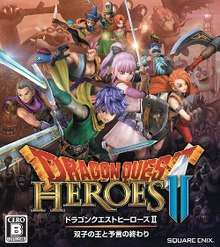Dragon Quest Heroes II
| Dragon Quest Heroes II | |
|---|---|
 | |
| Developer(s) | Omega Force |
| Publisher(s) | Square Enix |
| Director(s) | Tomohiko Sho |
| Producer(s) |
|
| Designer(s) | Michio Yamada |
| Programmer(s) | Yu Ito |
| Artist(s) |
|
| Writer(s) | Atsushi Narita |
| Composer(s) | Koichi Sugiyama |
| Series | Dragon Quest |
| Platform(s) | |
| Release |
PS3, PS Vita
|
| Genre(s) | Action role-playing, hack and slash |
| Mode(s) | Single-player, multiplayer |
Dragon Quest Heroes II[lower-alpha 1] is a hack-and-slash game developed by Omega Force and published by Square Enix for PlayStation 4, PlayStation 3, PlayStation Vita, Nintendo Switch, and Microsoft Windows. It was released in Japan in May 2016,[1] and worldwide in April 2017.[2] The game is a sequel to Dragon Quest Heroes: The World Tree's Woe and the Blight Below.[3]
Gameplay
Dragon Quest Heroes II mixes the hack-and-slash combat of Koei Tecmo's Dynasty Warriors series of video games with the characters, monsters, universe, and lore from Square Enix's Dragon Quest series. The game is heavier on the RPG elements than most of Omega Force's other titles. World exploration was changed to resemble the typical Dragon Quest experience. Players can move their party to visit towns, wander the world map and initiate battle stages (similar to dungeons). Seamless random monster encounters may break up the pace between locations. Special ingredients and treasure boxes can be discovered across the world map. Weather can fluctuate and affect the party's status. Rainy days inflicts a curse ailment on the party during battle.
Characters are able to dash to wherever they please, but certain areas are blocked until the player proceeds with the main story. As the players proceed with the main story, they can unlock "Invitation Stones" on the world map. These monuments allow the party to instantly warp to previously visited locations.
Zelbion acts as the new main town. One major change from the previous game's features is the class change feature for the main protagonists. Switching classes changes equipment types and potential skills for each protagonist. Known classes include martial artist, mage, monk, thief and warrior. The weapons merchant can teach random weapon skills to the protagonist, depending on their proficiency with each weapon type. Individual weapons and outfits have all been changed to only provide aesthetic changes. Accessories can still be strengthened to alter stats.
Battle stages are mandatory for progressing the main story and behave like battle areas from the previous title. Parties can still be changed by talking to Patty in her bar. Two player co-op is now available for the main story by selecting the "Assist" option in the main battle menu.
Alternatively, players can work together to complete the new "Time Labyrinth", a series of multiplayer exclusive stages aiming to appeal to longtime Dragon Quest fans. It is unlocked by finding labyrinth map pieces scattered throughout the main story. Talk to Erinn in town inns to set up online matching or send invites.
Up to four players can play together for multiplayer missions.[4] Online chat is not available, but players can select common stock phrases to communicate. Fallen party members can either be resurrected by "Leaves of the World Tree" or raise their alive companions' health and Tension by cheering for them. Players can work together to find more map pieces or defeat difficult bosses. Metal Slimes have a higher chance of appearing in these missions.
Cross-platform play options and save data sharing are present. Having save data from the previous title grants Luceus and Aurora costumes for this game's protagonists. Dragon Quest Builders save data grants "Builders Wooden Hammer" for the protagonists' use.
Plot
The story takes place in a peaceful land of seven kingdoms. Suddenly, as though enchanted by an ancient prophecy, the kingdoms wage war. The heroes from different kingdoms band together to restore peace to their torn continent.
Development
Dragon Quest Heroes II was developed by Omega Force, who are better known for their Dynasty Warriors hack and slash series. Dragon Quest Heroes I·II, a compilation featuring both games in the series, was released as a Japanese launch title for the Nintendo Switch in March 2017.[5] In an interview in April, series producer Ryota Aomi shared details about the game's plot and combat.[6]
Reception
| Reception | ||||||||||||||||
|---|---|---|---|---|---|---|---|---|---|---|---|---|---|---|---|---|
| ||||||||||||||||
Famitsu awarded it four scores of 10, 10, 9 and 10, which equaled a total of 39 out of 40.[11] More than 580,000 copies were sold in Japan.[12]
Notes
- ↑ ドラゴンクエストヒーローズII 双子の王と予言の終わり (Doragon Kuesto Hīrōzu Futago no Oh to Yogen no Owari) in Japanese
References
- ↑ Usher, William. "Dragon Quest Heroes 2 Announces Japanese Release Date". CinemaBlend. Retrieved 18 January 2017.
- ↑ Godhania, Sunil. "PS4 action RPG sequel Dragon Quest Heroes II releases 28th April 2017". PlayStation.Blog.Europe. Retrieved 18 January 2017.
- ↑ "A Beginner's Guide to Dragon Quest Heroes II, Out Today on PS4". PlayStation.Blog. Retrieved 2017-05-04.
- ↑ "Dragon Quest Heroes II Out Today on PS4 in North America and PC; Launch Trailer Released". DualShockers. 2017-04-25. Retrieved 2017-05-04.
- ↑ Van Duide, Erren. "Dragon Quest Heroes I and II coming to Nintendo Switch". RPG Site. Retrieved 18 January 2017.
- ↑ "An interview with Dragon Quest Heroes II producer Ryota Aomi". PlayStation.Blog.Europe. 2017-04-25. Retrieved 2017-04-26.
- ↑ "Dragon Quest Heroes II". Metacritic. Retrieved 2017-12-08.
- ↑ Carter, Chris. "Review: Dragon Quest Heroes II". Destructoid. Retrieved 25 April 2017.
- ↑ "Dragon Quest Heroes II Review". GameSpot. Retrieved 2017-04-25.
- ↑ Kemps, Heidi (2017-04-24). "Dragon Quest Heroes 2 Review". IGN. Retrieved 2017-04-25.
- ↑ Romano, Sal, 05.24.16 "Famitsu Review Scores: Issue 1434" (http://gematsu.com/2016/05/famitsu-review-scores-issue-1434). Gematsu. Accessed 20 January 2017.
- ↑ http://geimin.net/da/db/2016_ne_fa/index.php